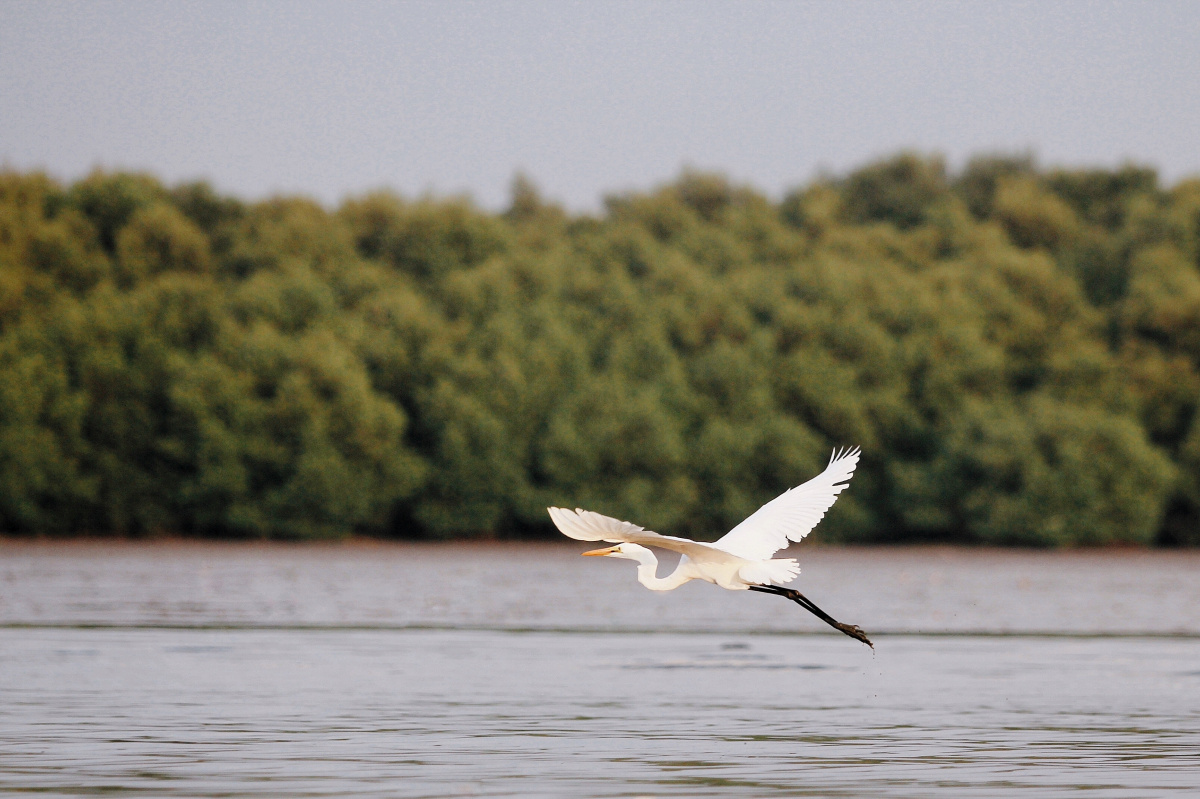Biodiversity negotiations must reconnect with reality
As the Convention on Biological Diversity (CBD) talks close in Geneva, Director of IUCN’s International Policy Centre Sonia Peña Moreno reflects on two weeks of negotiations, some missed opportunities, and her hopes for future meetings. Going forward, Parties to the CBD must reconnect with reality and continue to craft a simple, action-oriented post-2020 global biodiversity framework that clearly spells out what must be done to safeguard nature and the services it provides to humanity.

Egret crosses the lake; Jawa Timur, Indonesia
Photo: Andy Pinaria
The first in-person meetings of the Convention on Biological Diversity (CBD) in over two years opened on Monday 14 March in Geneva, Switzerland. If the opening statements were an indication, the meetings began with high expectations. Parties to the Convention stated their hope to advance a global plan to protect and restore biodiversity for the next decade and beyond (a post-2020 global biodiversity framework).
However, as the days went by, progress became elusive and was replaced by a lack of agreement. The draft text, even on seemingly uncontroversial issues, became full of brackets – denoting text that has yet to be agreed. The overwhelming number of sessions and side-meetings translated into fatigue, and the positive tone became one of frustration.
But as the negotiations close, despite the frustrations, we must look to the future. Negotiations will continue in June ahead of the meeting where the framework should be finalised and adopted later in the year in China (at the 15th meeting of the Conference of the Parties or COP15). We cannot afford for these negotiations to fail. We need an ambitious framework to halt the loss of biodiversity, restore and conserve the natural world, achieve a nature-positive world by 2030, and realise the vision of a world living in harmony with nature by 2050.
So, what lessons can be learned from these past two and a half weeks in Geneva?
Remember why we are meeting in the first place
The crisis the natural world faces will continue to have devastating consequences for humanity, and the science is clear that our window of opportunity to reverse these trends is narrowing. It will soon be too late. However, it seems that the Geneva talks were so muddled in brackets that the connection with reality and the urgency to act have been somehow forgotten. Parties must remember the facts, and deal with the reality.
They must also remember the real people who their decisions affect. In 2020 alone, at least 331 environmental and human rights defenders were killed for protecting their homes, lands and natural resources. The intervention outside the plenary room by civil society organisations and indigenous peoples’ representatives showing pictures of those killed and repeating “stop the killings” was particularly moving.
Finding compromise between the "Global North and Global South"
Many of the arguments used by regional negotiating blocks to propose new language or oppose others’ text call for increased ambition for the framework’s goals and targets, or voice the need to meet ambition with increased financial resources, capacity building, tools and mechanisms to support implementation.
The Global North and Global South dichotomy, familiar to the CBD, has resurfaced and is making progress extremely difficult. This is particularly true of already controversial subjects such as resource mobilisation, ‘biodiversity mainstreaming’, and access and benefit sharing of digital sequence information.
It seems that delegates have to be reminded that reaching consensus means compromising. Yet consensus does not (or should not) mean agreeing on the lowest common denominator or the least ambitious option.
Building a fit for purpose global biodiversity framework
I cannot overemphasise the importance of coming out of COP15 with an ambitious yet practical framework that guides sustained action to stop the loss of biodiversity and secure life on this planet.
IUCN has previously highlighted key points that the framework must address. As negotiations advance, other considerations for Parties include:
- The framework should complement not duplicate existing frameworks. It is essential that the framework is truly global and addresses threats to biodiversity as well as gaps that might exist in the Sustainable Development Goals: for instance, the interlinkages between biodiversity and human health.
- The framework should have focused, simple and measurable global Action Targets, so that their implementation and impacts can be monitored and assessed.
- The framework should reflect the path from where we are now to where we need to be in 2050. Action targets must be underpinned by a theory of change, which looks from now until attainment of the 2050 Vision.
- The framework should reflect the objectives of the Convention on Biological Diversity and the three components of biodiversity – species, ecosystems and genes – in coherent, distinct and ambitious outcome goals.
- The framework should ensure that targets are applicable, relevant and realistic at country-level, and so are “translatable” into concrete national actions.
- The framework should integrate Nature-based Solutions to safeguard and maintain ecosystems. These are vital for food and water supply, protection against natural disasters and provision of goods and services which are essential for human well-being.
- The framework should embrace all voices. Indigenous peoples and local communities, regional and city governments, the private sector, NGOs, women, youth and society at large must be invited to the debate. The framework should also incentivise their particular contributions towards the attainment of goals and targets.
Attention must be redirected. Negotiations should no longer focus on trying to get a detailed and complex framework in which each Party or stakeholder sees their views reflected, but must look to create a framework that makes sense not just to those involved in the discussions but to a wider audience. This framework should be an opportunity to convey in clear and simple language the suite of actions needed to safeguard biodiversity, and indeed all life on this planet.
Blog by Sonia Peña Moreno, Director of IUCN’s International Policy Centre



